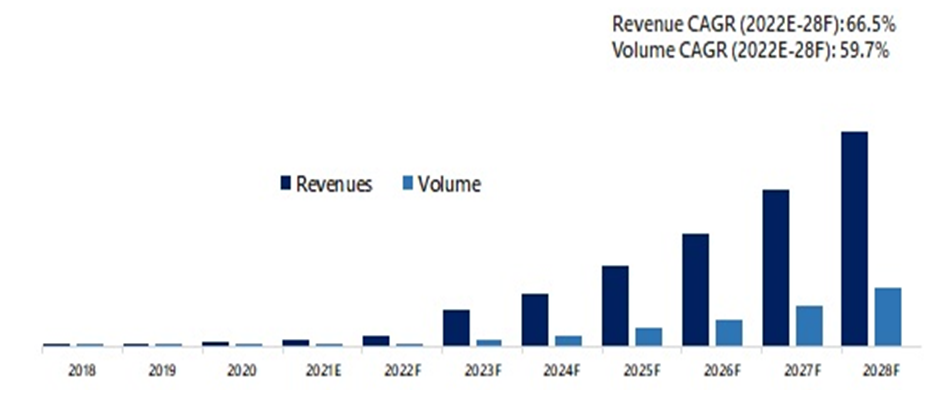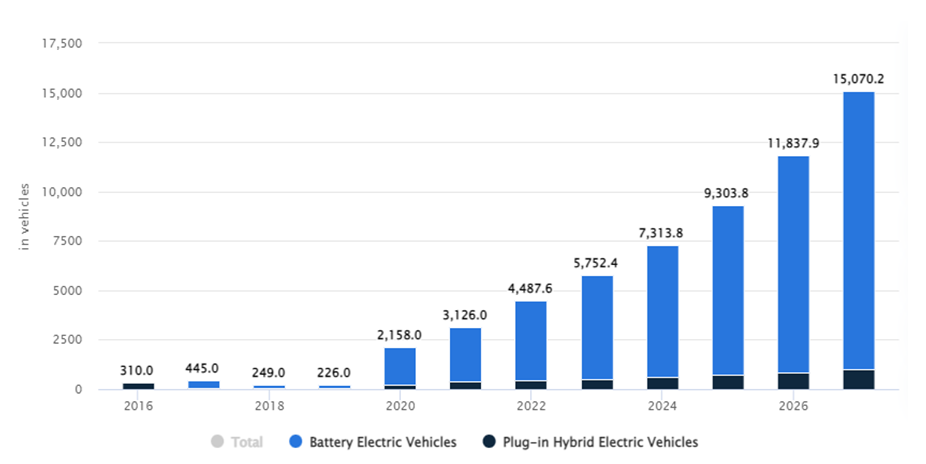-
Paper Information
- Paper Submission
-
Journal Information
- About This Journal
- Editorial Board
- Current Issue
- Archive
- Author Guidelines
- Contact Us
International Journal of Traffic and Transportation Engineering
p-ISSN: 2325-0062 e-ISSN: 2325-0070
2023; 12(1): 1-4
doi:10.5923/j.ijtte.20231201.01
Received: Feb. 9, 2023; Accepted: Feb. 21, 2023; Published: Feb. 23, 2023

The Future and the Effect of Using Electric Vehicles in Kuwait and UAE
Alhaifi N. A.1, Alazemi J.1, Alrajhi J. M.1, Alhaifi K. K.1, Alardhi M.1, Alkhulaifi K.2, Ahmed Khalfan1
1Automotive and Marine Dept., College of Technological Studies, PAAET, Kuwait
2Mechanical Power and Refrigeration Dept., College of Technological Studies, PAAET, Kuwait
Correspondence to: Alrajhi J. M., Automotive and Marine Dept., College of Technological Studies, PAAET, Kuwait.
| Email: |  |
Copyright © 2023 The Author(s). Published by Scientific & Academic Publishing.
This work is licensed under the Creative Commons Attribution International License (CC BY).
http://creativecommons.org/licenses/by/4.0/

This research is to review records and archival data to determine the status of electric vehicles (EVs) and their impact in Kuwait, the United Arab Emirates (UAE), and other developing countries. According to the findings, Kuwait lags behind the UAE in manufacturing and using EVs because it has yet to establish the necessary infrastructure, such as charging stations and manufacturing centers. However, it has laid programs to steer the manufacturing of EVs to gain the positive impacts of these vehicles, such as reduced emission of greenhouse gases (GHGs), reduced energy and maintenance costs, and increased efficiency. Indeed, EVs will be the main driver of the zero-emission goal, especially considering that Kuwait and other countries in the Gulf Cooperation Council (GCC) rely heavily on petroleum products in transportation.
Keywords: Kuwait, UAE, GCC, Electric vehicles, EV’s, Developing countries, Battery, GHGs, Electric power, Renewable energy, Carbon emissions, Charging stations
Cite this paper: Alhaifi N. A., Alazemi J., Alrajhi J. M., Alhaifi K. K., Alardhi M., Alkhulaifi K., Ahmed Khalfan, The Future and the Effect of Using Electric Vehicles in Kuwait and UAE, International Journal of Traffic and Transportation Engineering, Vol. 12 No. 1, 2023, pp. 1-4. doi: 10.5923/j.ijtte.20231201.01.
Article Outline
1. Introduction
- Electric vehicles (EV) use a lithium-ion battery, acid or nickel metal hydride batteries, or other sources of electric power for propulsion. The enormous volumes of greenhouse gases (GHGs) emitted by the petroleum-based transportation infrastructure have been the primary driver of the demand for EVs [1]. Unlike traditional fuels, EV’s is clean as it emits no emissions; therefore, it is a perfect innovation for the 21st century, where climate change mitigation is among the top global agendas. In 2021, the sale of electric vehicles reached a record of 6.6 million [2]. However, most of these occurred in Europe, the United States, and China. As this statistic indicates, the manufacturing and sale of EVs have been concentrated in the developed world. Thus, most of the research in this area has focused on advanced nations. However, such does not mean that the developing world is not participating in this technology. Many developing countries, including Kuwait and others within the Gulf Cooperation Council, like the United Arab Emirates (UAE), have followed the trend. As such, this research investigates the future and the effect of using electric vehicles in Kuwait and how it is compared with the UAE regarding EVs.
2. Literature Review
- There is little information related to the status of electric vehicles in Kuwait and other GCC countries. Rajper and Albrecht [3] indicated that the U.S. and China are the major players in the EV sector as they constitute about 65% of the users while Europe follows closely with 23% of the global share of EVs. Even within the Europe union, specific countries are the major users of EV’s such as Norway, the Netherlands, Sweden, and the United Kingdom. Unfortunately, except for China, developing countries seem reluctant to embrace EVs. According to Rajper and Albrecht [3], third-world countries that have invested in EVs make up less than 1% share of the global EV industry. Based on this study, it is logical to conclude that the manufacturing and use of EVs in the developing world are still growing. However, Rajper and Albrecht [3] recommended that developing EVs that resonate with the electric power structure in these countries can escalate their growth. Efemwenkiekie et al. [4] agree with Rajper and Albrecht [3] that the lack of a reliable source of electricity might be a significant impediment to the adoption of EVs in developing countries. Therefore, unless developing nations like Kuwait solve this challenge, they may continue to lag behind developed nations in terms of manufacturing and using EVs. Regardless, Efemwenkiekie et al. [4] revealed that developing countries can significantly reduce carbon emissions if they embrace EVs. What sets EVs apart from traditional models of vehicles is that they significantly reduce emissions of GHGs [4]. Therefore, an increase in the use of these vehicles in any country should reduce the quantity of GHGs emitted within its territory. EVs should improve the air quality in developing countries and thus reduce the prevalence of respiratory health complications. Ottesen and Banna [5] contribute to this discussion by comparing the status of EVs in Northern European nations and GCC countries. According to these authors, Northern European countries have promoted the demand for EVs by providing financial incentives to buyers. As a result, EVs make up more than 50% of new cars sold in this region [5]. In contrast, in the GCC region, EVs are less than 1% of all vehicles due to financial and non-financial obstacles [5]. Comparatively, the cost of driving for one kilometer in GCC countries is relatively lower when using gasoline than electricity, which differs from the European experience, where EVs facilitate cost savings. Sindi et al. [6] agree that EVs are yet to become as popular in the gulf region as in developed countries, but they also present an optimistic analysis. Many countries in this region, including the Kingdom of Saudi Arabia (KSA) and the United Arab Emirates (UAE), have pledged to support the Paris goal. KSA particularly intends to curb 130 million metric tons of carbon dioxide [6]. The UAE aims to enrich the proportion of its renewable energy mix. These goals have prompted GCC countries to invest in EVs. KSA has thirteen battery charging stations, while the UAE has more than 4000 EVs and several charging stations [6]. Also, Sindi et al. [6] agrees with Efemwenkiekie et al. [4] that EVs can help developing countries reduce carbon emissions. Alrajhi et al. [7] indicated that Kuwait was preparing to steer the adoption of EVs among its citizens, however, they did not clarify the current number of EVs in the country. The hesitation and postponing of EV’s in Kuwait might be because of its hot and arid climate, which may facilitate battery degradation [7]. The country also lacks crucial EV infrastructure like charging stations [8]. However, interviews conducted by Ottesen et al. [9] on 472 drivers in Kuwait reveal that the country has infrastructure for supporting EVs, such as charging stations. Most interviewees explained that they would easily charge EVs if they bought them. In conclusion of this literature, Kuwait and other GCC countries like the UAE and KSA have made strides in promoting EVs, such as building charging stations and other relevant infrastructure. Furthermore, these studies agree that developing countries like Kuwait can significantly reduce carbon emissions if they promote the adoption of EVs. However, the studies lack sufficient data on the real status of EVs in Kuwait and other GCC countries, and there is no clear comparison among these countries. Hence, this research will solve this gap in the literature.
3. Method
- The study employed a qualitative research design as it gathered data via records/archival data. It focused on determining the status of EVs in Kuwait and the UAE and the potential impact of these vehicles. As noted elsewhere, the literature does not offer detailed information on the progress of EVs in Kuwait and the entire gulf region. Hence, the only way to gather relevant data was through relying on data collected by 6Wresearch, Kuwait Ports Authority (KPA), the World Bank Group, Informa Markets, and Arab News.
4. Results
- A report by 6Wresearch [10] indicates that the EV market in Kuwait is at a growing stage, although it has a positive market outlook. In another report compiled for Informa Markets, Lewis [11] reveals that the government of Kuwait has laid down the necessary infrastructure to steer the manufacturing of EVs. According to this report, Kuwait Ports Authority (KPA) has approved a plan to dedicate one of the country's cities to manufacturing EVs, which will make the country the center for makers of EVs in the Middle East [11]. The following graph illustrates the status of EVs in Kuwait as of 2022 and how it might grow by 2028.
 | Figure 1. Kuwait electric vehicles market revenues and volumes [10] |
 | Figure 2. Number of EV’s and hybrid vehicles in UAE [13] |
5. Conclusions and Recommendations
- This research revealed that EVs in Kuwait and the UAE are in the growing stage, although the latter has made more significant progress. Overall, these countries and others in the GCC region have laid down frameworks for steering manufacturing of EVs to enjoy the benefits of these vehicles, like reduced emission of GHGs, increased efficiency, reduced energy and maintenance costs, and improved public health. However, Kuwait needs to speed up the building of charging stations and other relevant infrastructure as it lags behind other GCC countries like the UAE and KSA. Also, there is a need for future studies to focus on investigating how developing countries like Kuwait can align EVs with their electric power structures since it is the main impediment to the adoption of these vehicles.
 Abstract
Abstract Reference
Reference Full-Text PDF
Full-Text PDF Full-text HTML
Full-text HTML